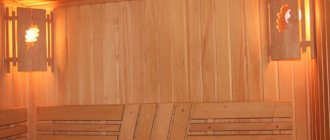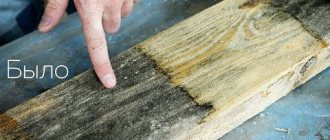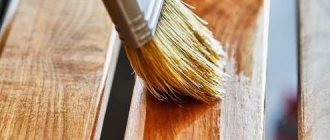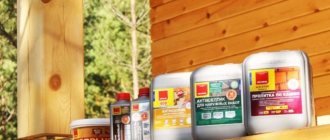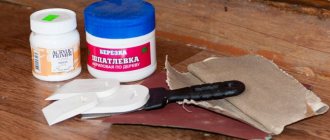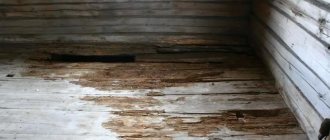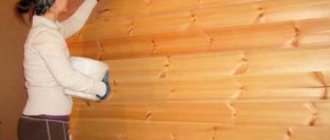Lining is a thin finishing board with a special tongue-and-groove joint. After covering the surface of the walls, ceiling or floor, it must be covered with protective compounds. It can be acrylic, stain, adhesive primer, drying oil, antiseptic, fire retardant or oil-wax. It all depends on the purpose and purpose of the protective layer. From this material you will learn in more detail how to treat lining inside a house, and why a protective layer is needed at all. And also, which manufacturers’ formulations protect wood better than products from other brands.
Processed lining with stain, as well as by brushing (aging) Source 2gis.ru
The need to process timber inside the house
The timber must be treated against moisture and rot, as well as to protect against fire
. Wood is susceptible to environmental influences; even the inside walls can suffer from negative factors:
- Moisture - a hygroscopic material quickly absorbs water that gets on the walls and is saturated with it from the air. An increase in humidity leads to swelling of the timber and is a favorable environment for the development of fungi and mold.
- Fire – wood is flammable and sustains combustion; in the event of a fire, the entire structure can be lost.
- Microorganisms – natural wood is a natural environment for the life of fungi, bacteria and insects. The affected material turns an unpleasant color and gradually deteriorates. Biological effects reduce the strength of the structure and shorten the service life of the home.
Particular attention is paid to the treatment of rooms with high humidity: kitchen, bathroom, sauna.
When to treat
The use of protective agents begins before the structure is assembled. Profiled and laminated timber needs protection from moisture. It is carefully coated with antiseptic on all sides. After the construction of walls and ceilings, this possibility will no longer exist; some of the lumber will become inaccessible. The wood is also impregnated with fire retardants to prevent combustion.
When choosing how to treat the outside of a wooden house made of timber immediately after construction, pay attention to the products of the Senezh company. These are hard-to-wash antiseptics, wood protectants with wax and UV filters, primers that will prevent the appearance of rot and insects. They penetrate wood well and form 2 levels of bioprotection. Experts recommend the use of protective drugs of the Russian brands Neomid, Belinka, Aquatex.
The compositions are applied during the first months after the construction of the building, without waiting for its shrinkage. The timber is coated with preparations simultaneously from the inside and outside. This procedure should be carried out regularly every 3-4 years.
Impregnation can be not only protective, but also decorative. It can lighten wood and give it a different shade. Glued laminated timber has an aesthetic appearance, so it is enough to paint it with varnish. After applying the antiseptic, it is better to cover the profiled material with clapboard.
What Causes Wood Rotting
Rotting is caused by wood-destroying fungi; this damaging factor poses the main danger to construction wood. Microorganisms destroy the cellular structure; each type of fungus affects the wood structure differently:
- White rot. The fungus transforms the wood structure to the state of rot, in the initial phase it appears in the form of characteristic white fibers,
- Brown rot. The fungus destroys wood cellulose, develops rapidly, the wood darkens, loses strength and collapses, damage to load-bearing structures by this microorganism poses a danger to the entire structure,
- Soft rot. The rotting process is formed upon contact with soil, the wood structure is loosened, saturated with moisture, mucus is formed, and the material loses strength.
Most often, buildings are affected by a fungus that forms white rot, it is called white house fungus (Coriolus sinuosus). This species has adapted to breed not only in wooden buildings; traces of its activity can be found in the basements of brick buildings and structures. Visible white fibers are mycelium, which compacts and turns into a film, the affected area turns into dust.
Fungal spores are found everywhere, they are easily carried by the wind; spore carriers can be birds, rodents and insects. Wood-decaying fungi can enter nutrient soil during wood harvesting, sawing and transportation. When favorable conditions are created, a mycelium is formed, the reproduction process occurs rapidly, the mycelium forms millions of spores per day. Rotting is promoted by a comfortable temperature - from 5 to 30 degrees, and high humidity of the wood pulp - more than 22%. Most often, rot affects the mortgage and lower crowns; the need to protect these elements is most urgent
Requirements for processing facilities
Internal treatment products must not emit harmful substances during operation.
Antiseptics and fire retardants must fully protect the wood from harmful effects. But no less important requirements are imposed on internal processing facilities:
- Environmental friendliness and safety - when choosing how to treat timber or logs inside the house, pay attention to the components of the preparation. You need to buy products without toxin additives and odor, preferably water-based products. They contain borax, boric acid, and sodium salts, which are antiseptics.
- Duration of action – the optimal period is 3-5 years.
- Cost-effectiveness - the criterion is determined by the ratio of the price of the material and its consumption.
Manufacturers take into account the specific application of the compositions, so they select safe ingredients. To avoid harm to health, choose products labeled “for interior use.”
Tools needed for painting
In addition to paint, workers will need the following tools:
- rubber gloves, possibly respirators and hats;
- brushes, rollers, paint trays;
- masking tape to avoid staining surfaces that will not be painted;
- sprayer, with its help painting is carried out much faster;
- a wet rag and a bucket of water to immediately clean up any spills.
There may be several brushes; if you use oil paint or alkyd enamel, stock up on solvent; you won’t be able to remove drops from these paints with water.
Preparing the surface for painting
Painting the walls in the house, the stages that precede it and, most importantly, painting, must be done with high quality.
Before painting, the surface is cleaned of old paint, dust, and greasy contaminants. The washed surface is left to dry. The cracks are sealed using acrylic sealant. This will protect against temperature changes and keep you warm.
Alignment
To obtain a smooth matte surface, the wood is processed using sandpaper or a grinder. Sanding allows you to smooth out irregularities, get rid of knots, and make small cracks invisible.
On even, smooth walls the painting material will lie more evenly Source mybesedka.ru
Painting technology
Before painting, the surface is treated with a primer. This will make the painting process easier and save paint. Applying one coat of paint is usually not enough. The second and subsequent layers are applied after the first has completely dried. The paint must be thoroughly mixed before application. First, use a brush to paint joints, corners, and places where it is impossible to reach with a roller. Then, the main area is painted with a roller. High-quality painting is done in 2-3 layers.
Video about painting a house:
Types of materials
To protect the timber inside the home, several preparations with different properties are applied sequentially.
Fire retardants
Chemicals once applied to the surface of wood significantly reduce its flammability. Fire retardants according to their mechanism of action are divided into two groups:
- Products that release non-flammable gases that block the access of oxygen to the surface of the wood. The base is ammonium sulfate or ammonia.
- Compositions containing low-melting salts of boric, orthophosphoric or silicic acid. They increase the combustion temperature and cover the wood with a fire-resistant film.
Fire protection products are available in the form of paints, varnishes or impregnations. Preparations of the first group of effectiveness best resist fire.
Antiseptic drugs
Compositions with antiseptics prevent the proliferation of fungal spores and mold, which cause allergies and bronchial asthma. They are created based on water, oil or organic solvent. For interior work, water-soluble products and products based on natural oil (linseed, hemp) are allowed. Depending on the type of action, there are two types of drugs:
- Impregnations - penetrate several centimeters deep into the wood, destroy existing microorganisms and prevent their further appearance.
- Film-forming compounds form a protective coating on the surface that does not allow moisture and biological pests to pass through.
Compositions for internal use are transparent (glaze) and covering. They give the wood the desired color. To change the tone of the timber while maintaining the structure of the wood, use a tinting antiseptic (stain).
Biopyrenes
Complex action preparations have antiseptic and fire retardant properties. They are approved for use in residential premises, children's and medical institutions. The compositions destroy fungi and insects and prevent their appearance. They are designed for processing hardwood and softwood timber.
Primer
Products with an antiseptic effect are used as a preliminary coating for surfaces before painting or applying varnish. They penetrate deeply into the wood structure and reduce the consumption of paints and varnishes.
Whitening products
Blue spots often form on timber and logs. This is one type of fungus that is difficult to remove. The damage is removed by sanding, but bleaching compounds completely eliminate it. Based on the main component they are distinguished:
- Chlorine-containing preparations are effective, but they are harmful to health and are used for external treatment.
- Based on active oxygen, the composition is safe, perfectly brightens and disinfects wood.
- Oxalic acid is a less effective remedy recommended for soft wood.
Bleaching agents are applied according to the instructions, left for the specified time and washed off if required by the manufacturer. To prevent subsequent infection, a deep penetration antiseptic is applied.
How to get rid of wood blue stains
An alarming “bell” is a change in the color of the wood and the appearance of bluish or blue-gray bald spots on the surface of the external walls; a log house under shrinkage is most often susceptible to this phenomenon. The appearance of blue discoloration is caused by the development of a fungus that feeds on wood starch and glucose. Blue appears actively in the first months after the construction of a log house; the cause of this phenomenon is most often the use of waterlogged timber.
It is believed that blue fungus does not destroy wood fibers, the tree retains its properties, but its appearance indicates that something is wrong with the wood material and measures must be taken. In recent studies, scientists have noted that blue damage does not go away without a trace; in the affected areas, an increase in pores is observed and hygroscopicity increases. This phenomenon reduces the service life of the structure.
The blue develops from the outside and penetrates deeply into the timber; sanding does not completely eliminate this defect; the façade of a house with blue-gray stains has an unpresentable appearance. Blue mold is easily eliminated with chlorine bleaches “Belizna”, “Iney”, “Sagus”. It is advisable to carry out the treatment immediately after the first signs of damage appear; if the timber is covered with blue in the stack, it is advisable to treat it before laying it in the log house and further dry it in a well-ventilated place.
Wood blue: 1-surface; 2-deep.
Preparatory work
After sanding, the wood absorbs protective compounds better.
Compounds should not be applied to old paintwork, dirt, tar or damaged timber. Before treating a wooden house outside and inside, the surface is prepared. Old paint or varnish is heated until softened and removed with a scraper. Then the log house is polished with a special machine. The procedure allows you to remove unevenness and defects, dark spots, and improves the appearance of the material. Removing the top layer opens the wood pores, allowing deep penetration of the impregnation. Grinding occurs with coarse and fine abrasives. After the procedure, the surface and surrounding objects are cleaned with a vacuum cleaner.
Brushing
This method of aging wood with your own hands is called from the concept brush, which translates as brush. The second name is tree structuring.
The degree to which it needs to age is determined by its purpose. If necessary, to create the appearance of deep antiquity, cutouts are made up to 3 mm. For floor coverings, such aging is not suitable, since it will collect a lot of dirt, and it is difficult to wash it off. On average, a depth of about 0.7 mm is left. Only hardwood can be aged using this method. Brushing wood improves its quality characteristics. It becomes stronger, lasts longer, and is not susceptible to attack by fungi and parasites.
Tools and materials for processing
The basis of the brushing aging method is cleaning with a hard metal brush. Soft fibers are cleaned manually. Using this tool, a relief is formed. The shorter the bristle of the brush, the more it will age after the procedure. Using a chisel, apply straight deep stripes, changing their curvature. Sandpaper is used to emphasize the resulting effect.
After the first stage is completed, the wood is coated with paint that has its own natural wood shades. The coloring composition is applied unevenly on purpose. This is how the upper layers age, they acquire a dark shade, while the lower ones remain lighter. The relief after this coloring stands out even more. The ideal texture of aging wood is created by gray-white paint. Before it completely dries, the top layer is wiped off the surface. The result is the appearance of a tree that is at least 10 years old.
Processing technology
Before aging by structuring, the wood must be prepared. Lumber is selected without defects with a moisture content of 10-15%. Otherwise, the fibers will not be processed and will break. How to properly age wood with your own hands:
- Moisten the surface so that there is not a lot of dust during work.
- The brush should move in the direction of the grain. Remove only soft wood fibers.
- The speed should be moderate so that the wood does not heat up.
- Primary grinding is done with a polymer brush with abrasive. Remove torn fiber residues using sandpaper. After removing the roughness, it will become clear how well the aging was done.
- If necessary, make the grooves better by brushing again.
- Decoration is done with a chisel. The appearance of cracks is created.
- Polishing. It is carried out with a sisal or hair brush, if aging is carried out with a grinder or a grinder. The final appearance of the workpiece is given. For the same purposes, fine-grain sandpaper is used for manual processing.
- Next, the piece of lumber needs to be dried and then completely cleaned of dust.
- A layer of stain creates a contrasting pattern. A generous layer without rubbing and quickly removing excess will dye soft fibers and leave hard fibers light. Gold and silver colors look especially advantageous if the wood is aged.
- Patination is the darkening of deep furrows. Gives nobility when aging.
- Finally, polish again, erasing any unevenness after painting.
- Varnishing is done with parquet varnish.
If you age the workpiece in this way, it will preserve the characteristics of the breed for a long time.
DIY application technology
The treatment is carried out in a ventilated area.
After cleaning the sanded timber, you need to inspect its surface. Areas darkened by fungus are treated with a bleaching compound. It is applied with a brush or roller and thoroughly rubbed into the surface. The remaining solution is washed off after 10-12 hours. Work is carried out in a ventilated area.
Treating a house made of timber begins with applying an antiseptic. Impregnation is carried out manually (brush, roller) or using a spray gun. The mechanized method speeds up the work and reduces labor costs. The advantage of brushing is the ability to treat hard-to-reach areas. The antiseptic is applied in 1-2 layers, taking a break until it dries completely. The lower parts of the house and rooms with high humidity (bathrooms, bathrooms, kitchens) are coated with special care.
Next, the timber is treated with a fire retardant, and the solution is applied in the same way. If complex protection with biopyrenes is used, then the two stages are combined into one. Before finishing, the timber is coated with a primer. After it dries, a coloring composition or varnish is applied.
How to apply impregnation
Depending on the type of compounds used for the log house, the method of applying them may differ. There are several methods of applying impregnation:
- Use of rollers and brushes. This method is more time-consuming and is suitable for applying thick, viscous mixtures.
- Use of spray guns. This method is considered high quality and less expensive.
- Sprayers are suitable for applying only aqueous solutions. The procedure is carried out using special equipment - glasses, a respirator and gloves.
- A method of immersing logs in baths with prophylactic compounds. This approach allows for deeper and higher-quality impregnation of the structure in hard-to-reach places.
- Method of diffuse (dry) impregnation. Suitable for cases where an antiseptic and fire retardant are used in the form of a paste or powder.
If all rules for processing logs are observed, subsequent activities are carried out after 3–4 years. Many high-quality drugs retain their unique properties for 6 years.
Recommendations for internal processing
The work is carried out at above-zero temperatures.
If the construction of the house was completed in the winter, the treatment should be postponed until the onset of a thaw. Most formulations are applied only at above-zero temperatures. In frost, untimely impregnation is not dangerous, the tree does not absorb moisture, and insects and fungi are inactive. For water-soluble drugs, the minimum application temperature is +10°C.
Work begins from the bottom of the building, which has constant contact with moisture. It is necessary to cover the subfloor boards and the lower floor with protective agents. The next step is the processing of walls, ceilings, floors and other wooden structural elements.
Protective agents are applied sequentially: antiseptic, fire retardant, primer, finishing treatment (acrylic-based paint composition, varnish).
Formulations for internal use are subject to special safety requirements. Choose water-based products without organic solvents or synthetic oils. They should be odorless and have good vapor permeability.
It is recommended to apply the preparations in several layers, this will ensure deeper penetration into the layers of wood, long-lasting and reliable protection.
In what order are the compounds applied?
If the wood is in good condition, you need to start with fire retardants, then treat it with an antiseptic, and use preservatives before applying the finishing coat. If the tree is damaged by bark beetles or mold, then first a primer with active fungicides (Neomid, Pufas) is applied, then fire retardants (although some prefer to do without them altogether).
If the tree is already infected with insects and there are probably bark beetle larvae in the depths, this scourge must be dealt with radically. It is not enough to simply apply an antiseptic with a brush. Firstly, a separate product is required (Antizhuk, Lignofix concentrates), and secondly, the application methods are different - injecting or intensive spraying.
Of course, we did not include tinting, putty and other products responsible for decorative design in the list. Their use is dictated only by the taste and needs of the home owners.
No. 6. Wall panels
Thanks to the use of wall panels, walls can be transformed beyond recognition and completely any design idea can be realized; with their help, only certain areas are often decorated: above the bed, kitchen apron, near the bathroom. Wall panels are made from different materials:
- wood and bamboo;
- veneered and laminated MDF;
- glass (transparent, frosted, printed);
- leather;
- plastic.
Panels can be type-setting or panel-type. Stacked ones have a large length and a small width, and are connected according to the tongue-and-groove principle. Wooden lining, in fact, belongs to panel wall panels, but its wide distribution and unique properties have made it possible to distinguish it into a separate class of finishing materials. Panel panels already have a more comparable length and width.
Wall panels are attached to the lathing, the pitch of which depends on the parameters of the finishing material. The variety of designs cannot be described in words, but not all such panels meet the requirement of environmental friendliness: leather and glass will not disturb the microclimate, which cannot be said about plastic panels. However, even plastic panels, incl. and plastic lining have the right to be used for finishing a bathroom, toilet or kitchen.
Plastering rules
When increasing the use and aesthetics of wooden buildings with the help of plaster, special rules are observed. There is a difference between finishing log houses and frame houses. The influence of temperature and humidity parameters on the expansion and contraction of wood is taken into account.
Only the wooden surfaces of the frame structures are plastered without delay. Such walls do not carry a load, but serve only as thermal insulation, and therefore are not subject to shrinkage. The house is finished with plaster both inside and outside.
New or repaired log houses are left under the roof for 1-3 years to shrink. During this period, natural shrinkage of the wood occurs, as well as mechanical shrinkage: compression of logs under the influence of weight, compaction of inter-crown insulation. The period of maintenance of a building also depends on the direct influence of atmospheric influences on the frame, the type of wood, and the processing method.
Mesh for plastering wooden walls
Work is carried out at a temperature of +10о – +20оС. Negative atmospheric influences (heat and frost) affect the binding of the solution to the wood. The coating cracks and peels off.
